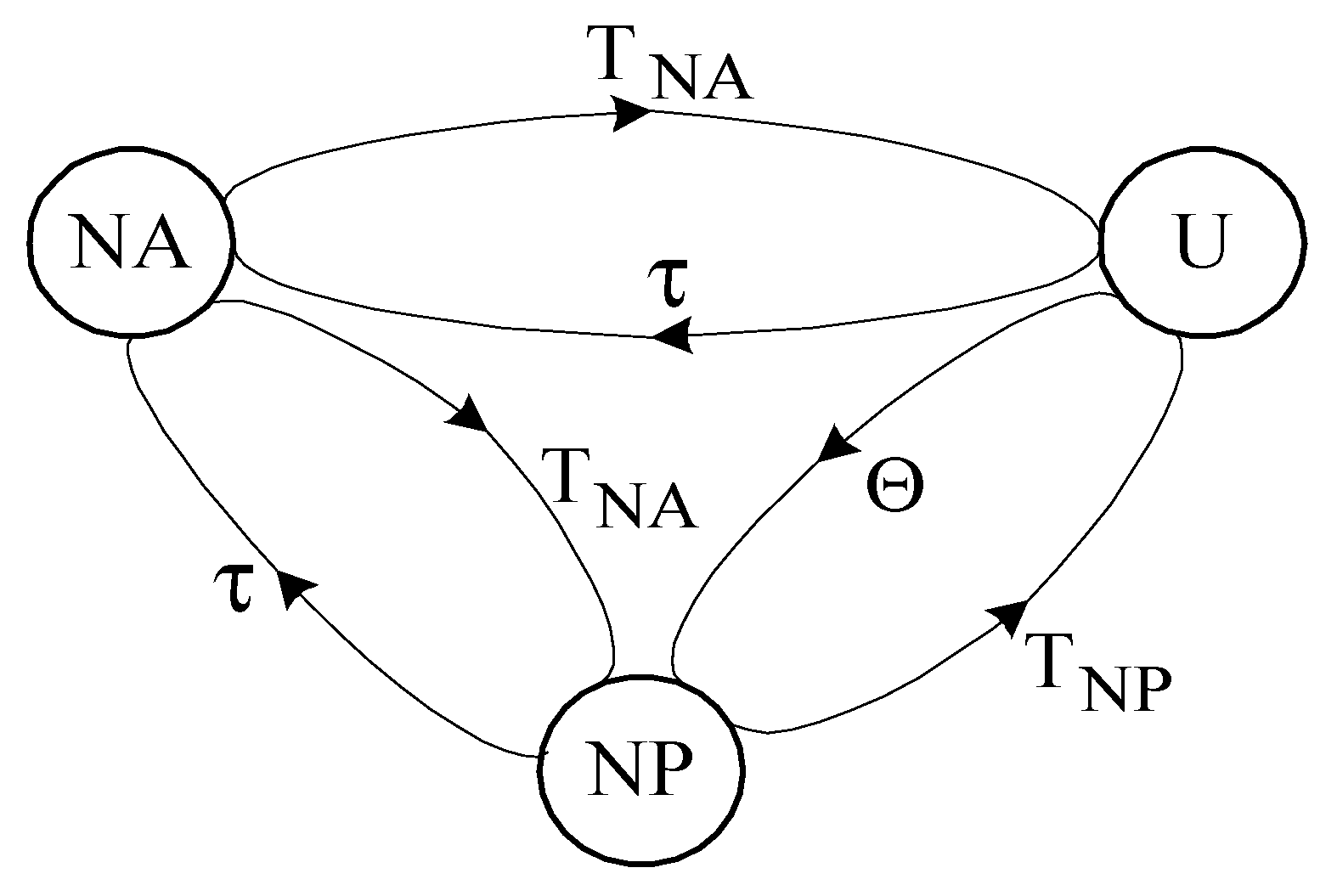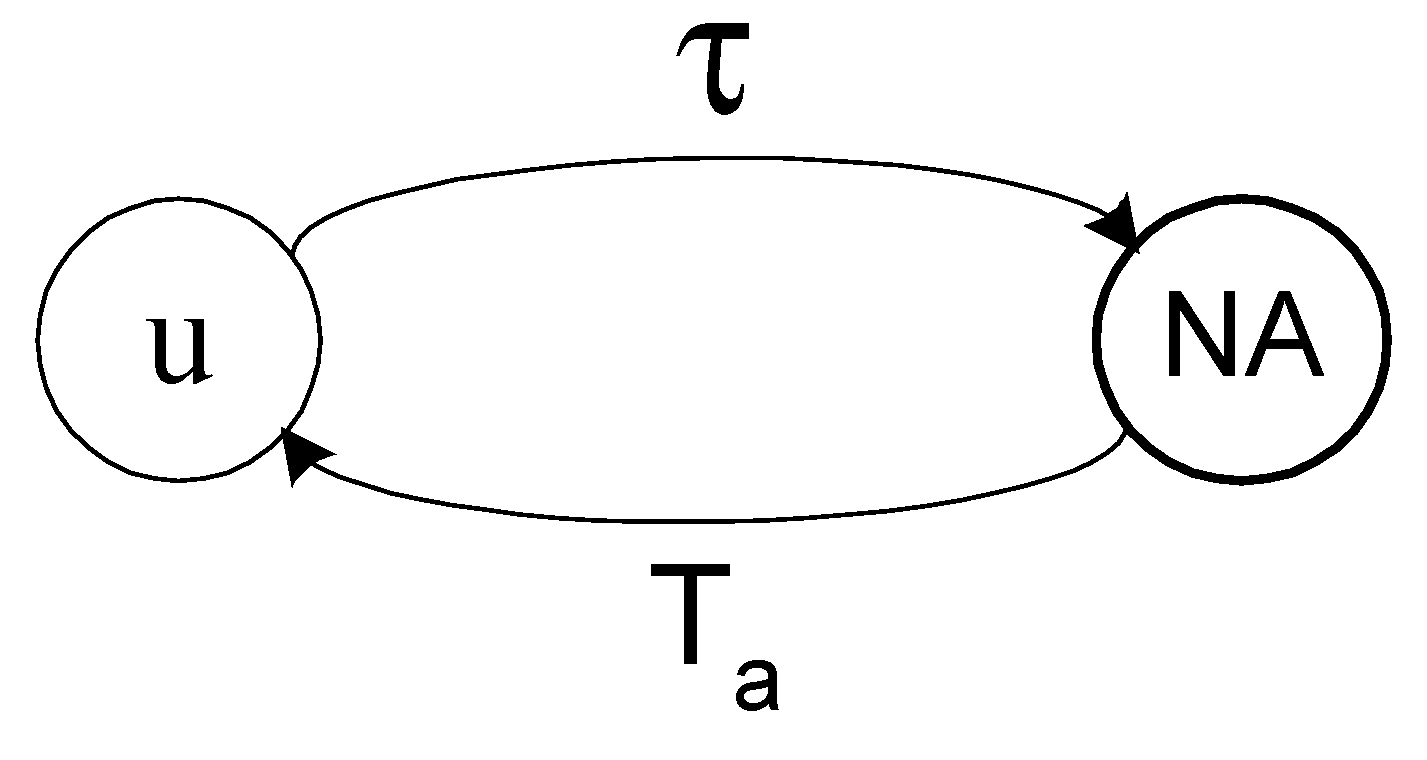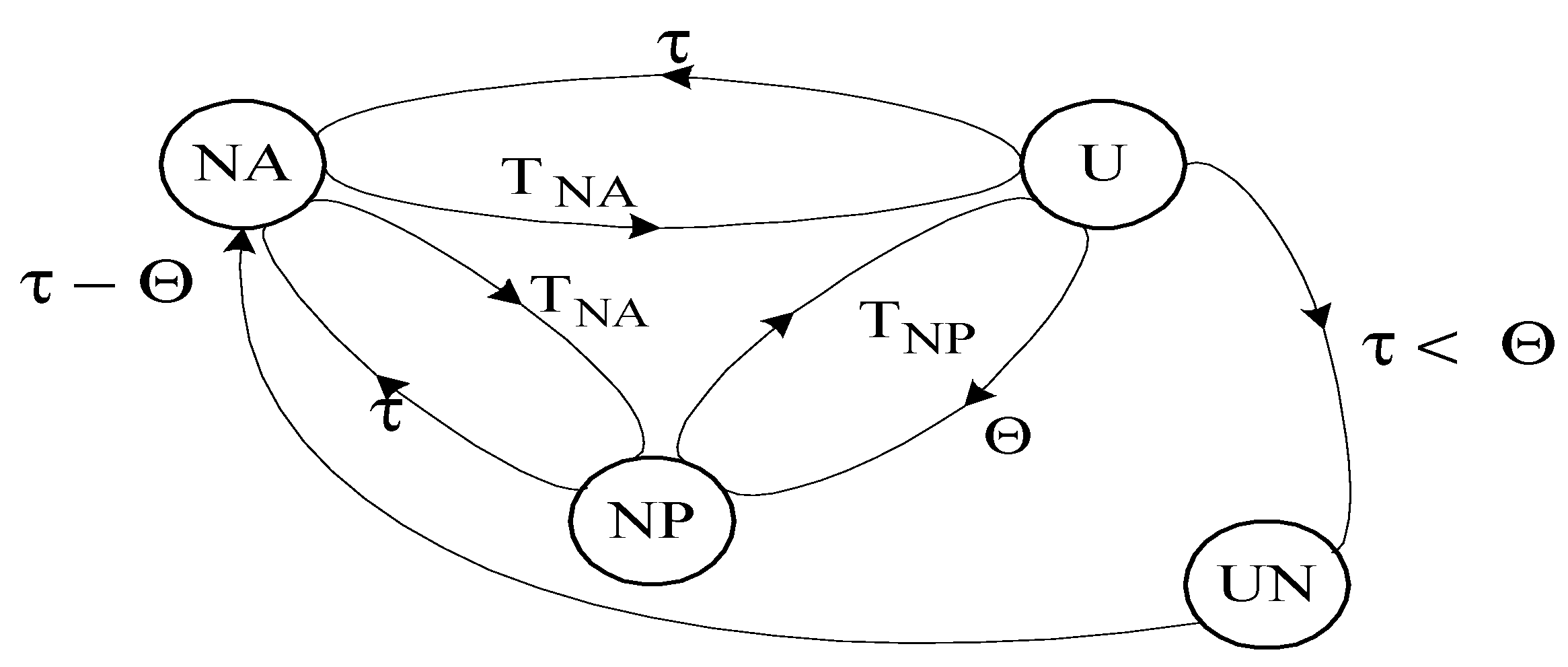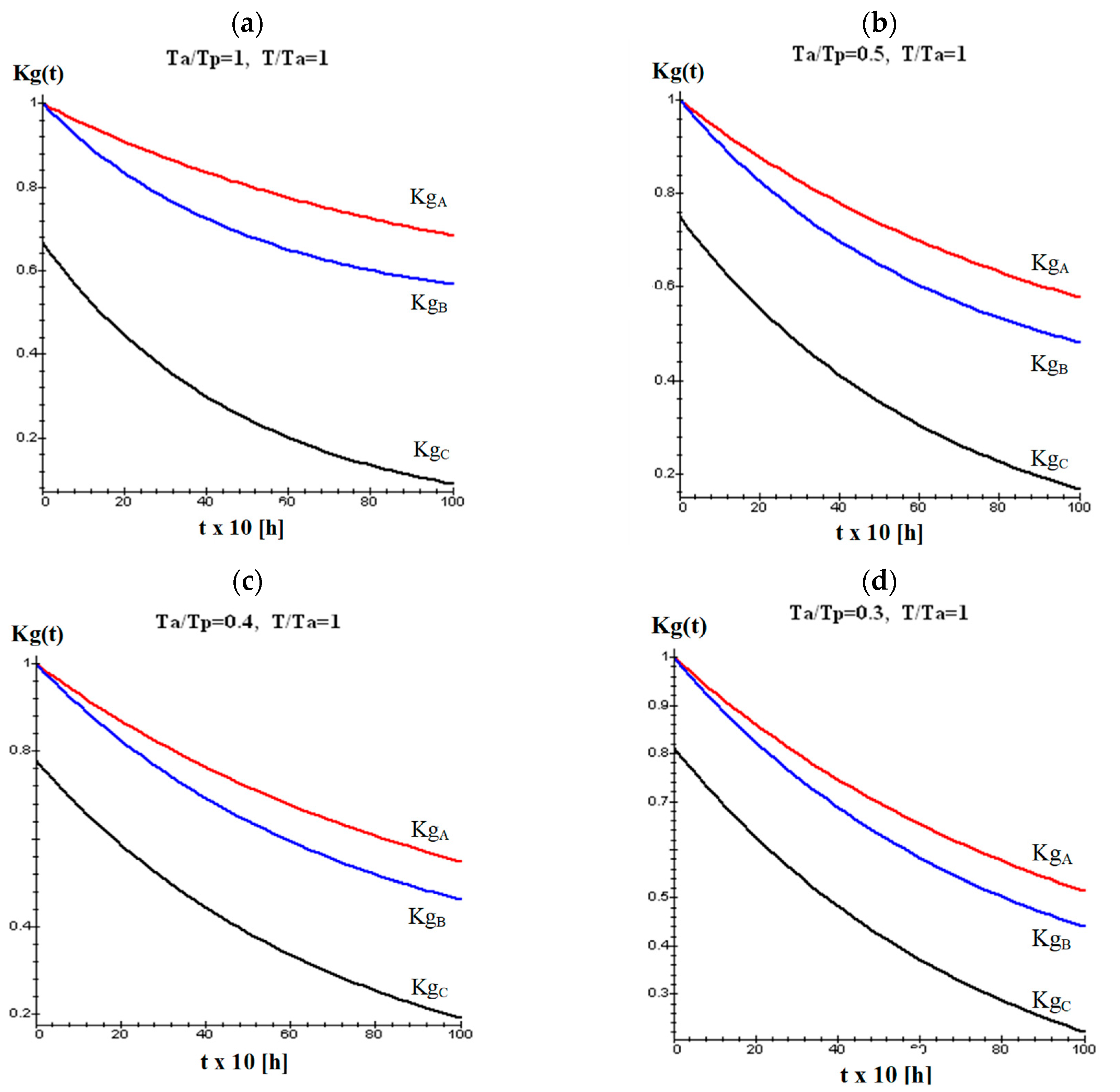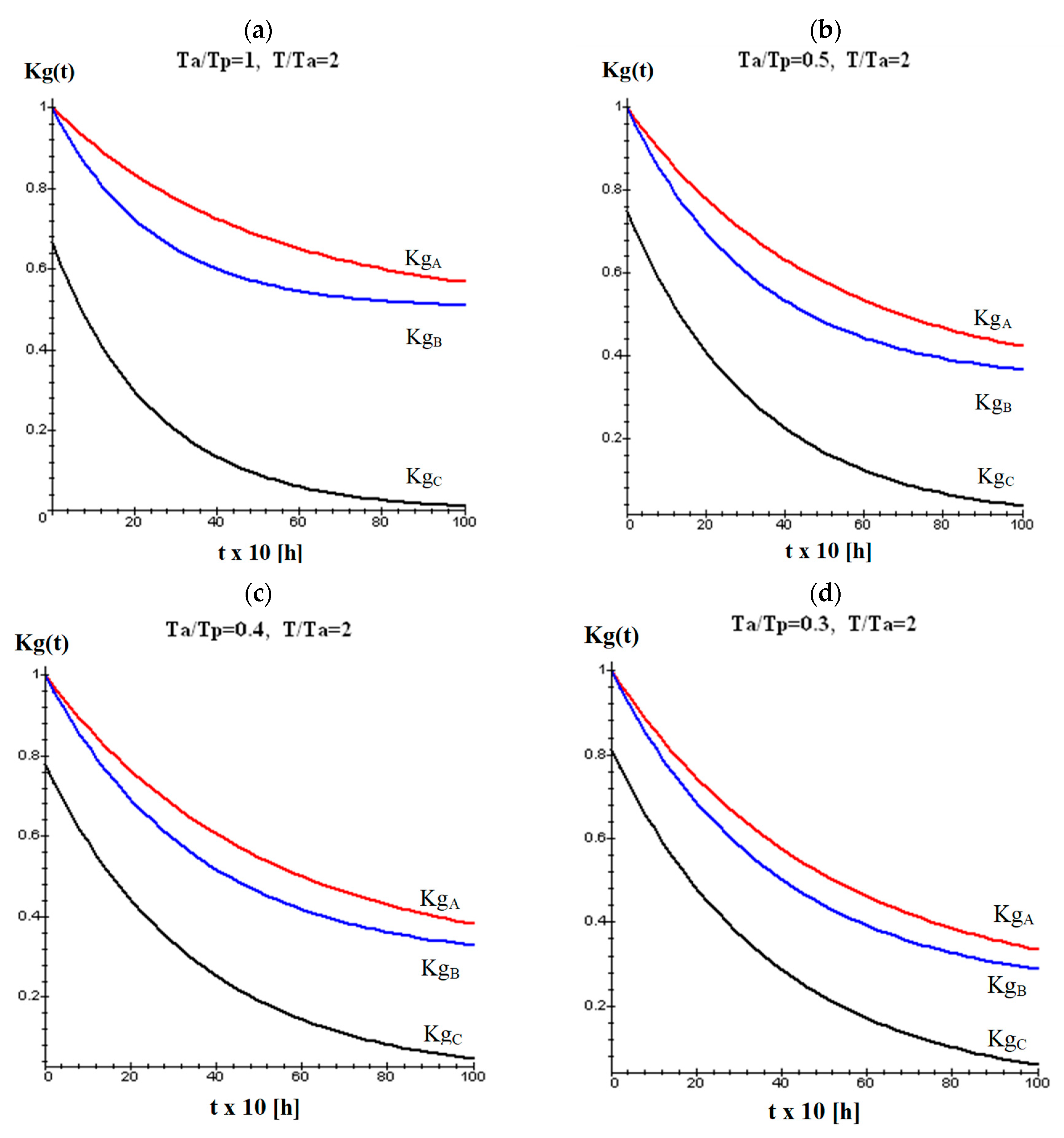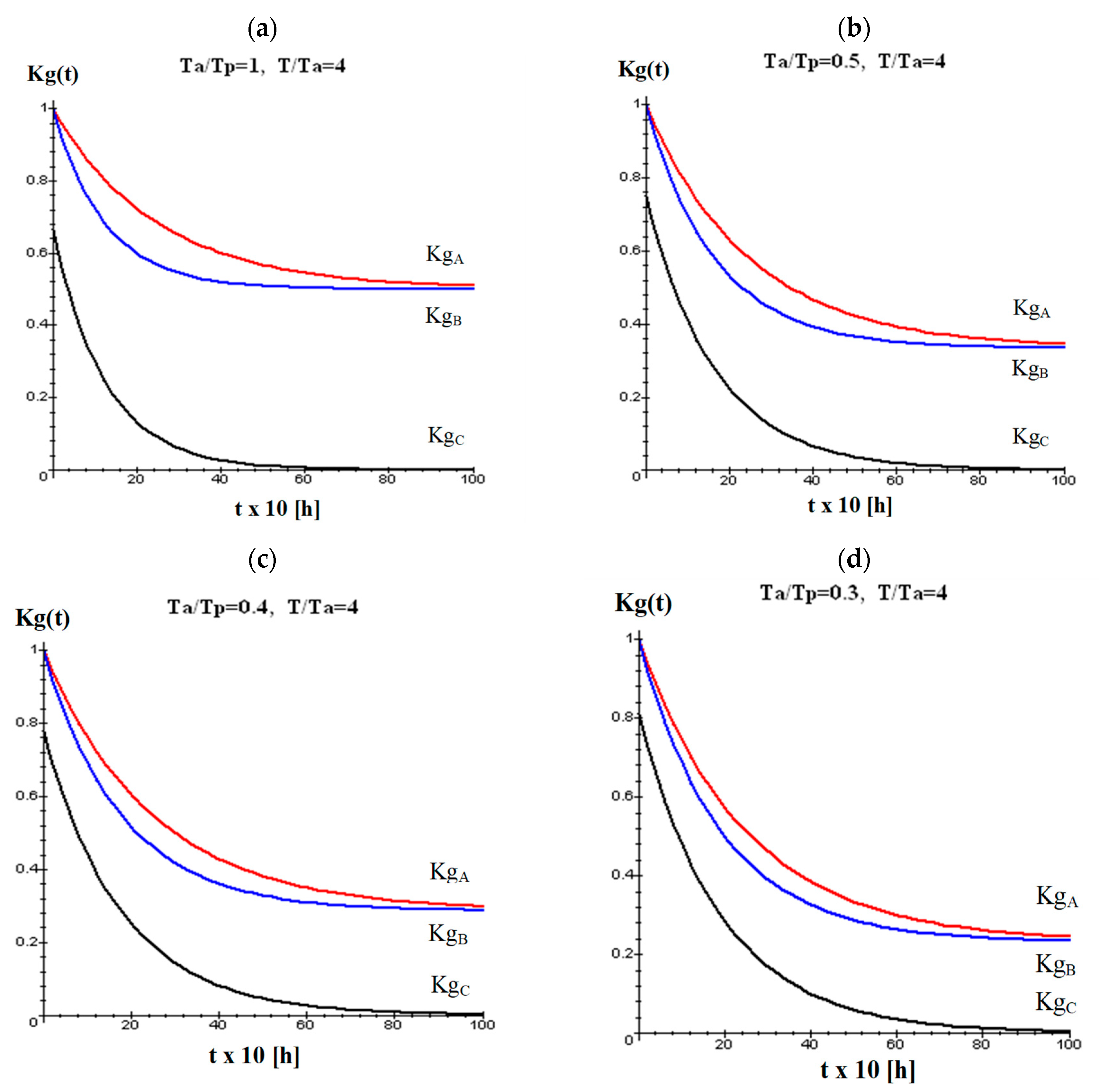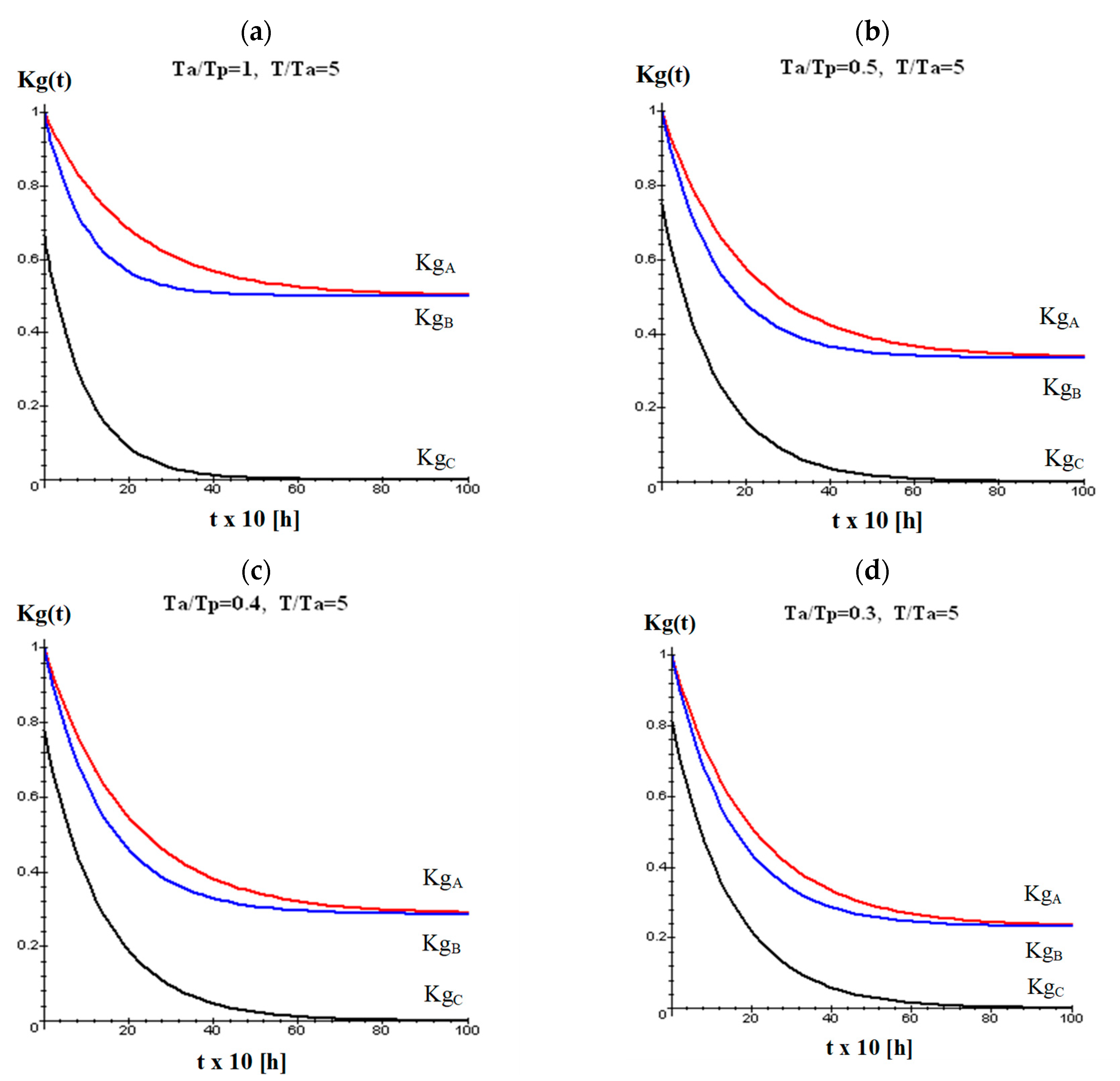1. Introduction
The problem of sustaining the operation of special technical objects required for continuous use or duty such as medical devices, airplanes equipment, radar systems or energy generation devices requires a different approach to the problem of their prevention and/or maintenance. For such devices, the requirements for monitoring their state and adequate maintenance activities are of utmost importance. One solution to increasing demands for deeper automation and minimizing human factor for these kinds of processes may be broader implementation of artificial intelligence methods, combined with novel diagnostic approaches utilizing 3-value logic. Other significant advantages of maintenance systems organized with such approach are cost-effectiveness and significant reduction of time of system response. The results of initial studies of the organization of systems for automatic regeneration of functional properties of complex technical objects constitutes the basis for the optimization of the costs of prevention activities and reduction of response time [
1,
2].
The present article covers issues of a qualitative assessment of the renewal process of the operational characteristics in compound technical objects in an intelligent maintenance system. The issues related to the investigation of the operation process of compound technical objects are not presented in a comprehensive approach in the literature. The operation process of compound technical objects is a complex random technical and technological process. The process of the operation of objects and technical devices is defined as a random set of the states of the use and maintenance of the technical object. The complexity of this process results from the complexity of those events (elements) which describe this process and occur in this process. The set of those elements that occur in the operation process of the object which require description and research includes the following: the technical object, the diagnosing process of the object in the state of its use and the maintenance process of a given object. The issues concerning the description and examinations of the individual elements that describe the operation process of technical objects are well presented in publications. However, there are no studies which comprehensively present the issues of the examination of the operation process for complex technical objects.
The study by L. Bedkowski & T. Dabrowski and others [
2,
3,
4,
5,
6,
7,
8,
9] presented mathematical basis of the reliability of technical devices and a description of mathematical models of the reliability of technical devices. Description and analysis methods of the reliability of the technical devices tested were presented.
The technical object itself forms the basic element in the operation process of the object. The issues concerning the description of the technical object form the basis of those publications that deal with the diagnostics and reliability of technical devices. In these publications, the technical object is presented in the form of its model. The model of the technical object is most frequently presented in the form of a functional and diagnostic model. Based on this model, the internal structure of the object is presented, which forms the basis to determine information on the object of research: a set of basic (constructional) elements and a set of required diagnostic signals. The abovementioned information constitutes the basis in the reliability and diagnostic examinations of technical objects. Issues concerning the presentation and modeling of technical objects are covered in those publications that describe reliability and diagnostic issues.
The author’s own studies [
5,
6,
7,
8,
9] constitute a new approach in the issues of the modeling of the technical object. The method to describe the internal structure of the technical object was presented in these studies. A decomposition of the object’s structure is performed for this purpose to determine the set of basic (constructional) elements of the object. The technical object {O} is divided into levels, which are the ith functional units (systems) {E
i}, levels—the object’s functional units are divided into layers that include the jth basic elements. As a result of such a decomposition of the object, a set of the basic elements of the object {e
i,j} is obtained. This division of the internal structure of the object is the most adequate one to being present in the model for the matrix form. In the matrix form of the model of the object’s structure, matrix lines correspond to the levels—functional units (systems) of the object. Matrix columns present the arrangement of the primary elements of the object in a given ith functional unit of the object. Therefore, a matrix with a specific ith number of lines and a specified jth number of columns constitutes the model of the object’s internal structure.
Another direction of reliability testing in the operation process of technical objects and systems is the use of Chapman–Kolmogorov equations in them. This is particularly evident in the works by J. Dyduch and others [
10,
11,
12,
13]. In their works were presented research and an analysis of power supply systems in transport telematics devices (PSSs in TTDs). The presented PPS consisted of a main power supply and a standby one. This enabled describing it with Chapman–Kolmogorov equations. The solutions lead to obtaining dependencies determining the probabilities of the PSS in TTD of staying in their functional states (full ability, partial ability, unreliability) in symbolic terms. The consecutive analysis determined the dependence between probability of PSS in TTD staying in full ability state RO and time restoring this state.
Technical diagnostics of technical devices is another essential problem which forms the basis in the organization of technical operations. The diagnostic examinations of devices are oriented towards the examination and identification of the technical state of the object examined. In the diagnostics of technical devices, the recognition of states in bivalent and trivalent logic is used. In the organization of the operation process, which renew the technical object, diagnoses determined by the diagnostician using trivalent logic are of the greatest practical significance. The studies by S. Duer [
4,
5,
6,
7,
8,
9] constitute the canon of achievements in this area.
The study by W. Kacalak et al., Z. Palkova et al. and others [
14,
15,
16,
17,
18,
19,
20,
21,
22,
23,
24,
25] includes a description of an effective measuring track, which constitutes an important element in the structure of a diagnostic system. In addition, theoretical grounds were presented for designing of a measuring system with the use of a computer measuring card, the task of which is to create a measuring database for the diagnostic system. The results of the study were supported with an example of an information measuring database for the device tested.
Issues regarding the use and operation of electrical equipment in wind farms and wind farms are presented by B. Badrzadeh et al., N. Pogaku et al. and others [
1,
26,
27,
28,
29,
30,
31,
32]. The works on the construction, functioning and modeling of electrical devices located in wind farms are well developed in these works.
The study by J. Dyduch, B. Epstein et al. and M. Siergiejczyk et al. includes a description of reliability–exploitation analysis is vital [
12,
13,
30,
31]. Electromagnetic compatibility of applied electrical and electronic devices is equally relevant, but this aspect is not scrutinized in this article. yet one must not ignore the influence of electromagnetic interference on the functioning of electronic devices [
29,
30,
31].
An essential element in the modeling of the operation process for complex technical object is the development of a model of the renewal process for an intelligent maintenance system. These issues are presented in publications including those by B. Buchannan et al., S. Duer and others [
4,
5,
6,
7,
8,
9,
14,
15,
33,
34]. In his studies, the author presents issues related to determination of the systems maintenance models. For this purpose, the form (dimension) of the matrix of the object’s structure is accepted. It is transformed to the form of the object’s maintenance matrix. Elements in the maintenance matrix are assigned to the primary elements of the object. The elements of the object’s maintenance matrix describe explicitly the subsets of those technical and technological activities which must be performed upon a given element of the object in order to its renewal. The process of assigning the elements of the object’s structure to the adequate renewing activities with the use of appropriate materials and resources is a complicated task. These issues are continuously being developed and improved in the author’s studies.
The issues of the modeling of the operation process of technical objects are presented in the following publications by T. Nakagawa, L. Pokoradi and others [
2,
5,
6,
12,
30]. The author’s studies [
3] are important here, as well. In these studies, a mathematical approach is presented in the modeling of this process. The author interprets the states of the object in the operation process and the essence of changes (transitions) between them. An important element in the modeling of the operation process of the object is a presentation (use) in it of an approach to the organization of the object’s renewal process in the maintenance system. A new approach that is developed in the author’s studies is the use of the current state of the object in the organization of the operation process, which is known as the operation of the object according to its state.
The subject of the article concerns the study of the efficiency of the operation process of complex technical objects of the class such as Wind Power Plant Equipment (WPPs). The subject is new in the literature. The study of the effectiveness of the process of operating complex technical objects is a complex process in the sense of its description and practical implementation. This type of study can be carried out in two ways. It is possible to perform the first one on the basis of testing the actual operation process of technical objects and devices while using them “during the object’s life cycle”. This examination, due to the long period of such examination, is unprofitable and expensive considering the duration of the examination. The second method of this study is implemented as a simulation based on models developed of the process of operating technical objects. In simulation tests of the operation process of wind farm equipment, a number of models on the basis of which the test will be performed need to be developed. The set of these models that appear in the operation process models include:
- −
technical object (WPPs);
- −
WPPs diagnosis process (system);
- −
the technical maintenance process of a given object (WPPs);
- −
WPPs operation process along with the adopted method of renewal.
For the purpose of a simulation testing of the wind farm operation process, this article presents three of its models.
Model A: an operation process of a wind power plant that uses an intelligent maintenance system with an artificial neural network.
Model B: an operation process of the object that uses information in bivalent logic: a model with a maintenance system organized by planning of its optimal prevention activities,
Model C: an operation process of a wind power plant with a maintenance system that is classically organized without any examination of the state in the assessment process: a strategy for the maintenance of the object with the period of prevention activities being planned.
Model A describes the process of operating wind farm equipment with a technical maintenance system implemented on the basis of diagnostic information regarding test information, and identifying the technical condition of the object tested. In the diagnostics of wind farm equipment, its diagnostics with states recognition in two- or three-valued logic is used. Diagnoses that include diagnostics using trivalent logic that renews the technical object are of the greatest practical significance in the organization of the operation process. The artificial neural network used in this model indicates that the diagnostic system used in this WPP exploitation process is an intelligent system. A description of this process of diagnosis with an artificial neural network is not the purpose and topic of the issues presented in this article. There are other models of the WPP exploitation process that are known and described models that appear in the studies contained in the bibliography.
Simulation tests of the operation process of technical objects must be carried out on the basis of input data. The input data in these simulation tests are determined on the basis of an analysis of the wind farm equipment operation process (WPP). The above-mentioned data are related to:
- -
trouble-free operation of a wind power plant (WPP);
- -
working time between wind farm damages (WPP);
- -
duration of wind farm repair (WPP);
- -
duration of inefficient wind farm shutdown (WPP).
This work presents a simulation study using the MATLAB program for the operation process of wind farm equipment. An important part of simulation research is to develop models of the process of operation of the tested system. The study describes the full program of simulation tests. At a later stage of the research, the Chapman–Kolmogorov equations will be undertaken and applied for this type of research.
3. Program for Simulation of Qualitative Indexes in the Operation Process of Wind Power Plant
The traditional manner of the organization of prevention activities of wind power plant formed a system approach to the problem of maintenance among specialists and developed positive habits in the approach to technical devices (
Figure 4). It is particularly evident in the scope of the organization of maintenance of power generation systems. A recognition of this system approach to the issues of the organization of technical maintenance constitutes a base in the development and improvement of operation knowledge. On this basis, the conduct of those specialists who regenerate wind power plant was studied and described in the form of algorithms.
For the needs of this study, the methods to obtain maintenance knowledge in the form of analytical knowledge were formalized. Specialist knowledge in this form has become the basis for the construction of intelligent maintenance systems. A method was developed to transform the available specialist knowledge of the human concerning the organization of prevention activities to a form which enables its use by the computer technology [
9,
11]. Determining the bases of the organization of intelligent maintenance systems offered a solution to the problem concerning coming into existence—the creation of the second element in the system of automatic regeneration of the functional properties of wind power plant, which is the regeneration unit of the use resource of the object. The issues of the maintenance of wind power plant known as the objects of continuous use or of readiness state for use, such as: medical devices: those which sustain life (an artificial lung–heart), etc., planes, radar systems, energy (powering) devices, etc. require a different approach to this class of devices: a manner of prevention activities for these devices. An automation of the organization process of the maintenance of the wind power plant devices with the use of intelligent diagnostic and maintenance systems creates the bases for the optimization of costs connected with the organization of prevention activities. The designed system of an automatic regeneration of the functional properties of wind power plant forms the bases for an optimization of costs connected with prevention activities. This system fully minimizes the costs connected with the organization of the maintenance system of an object (
Figure 1,
Figure 2 and
Figure 3).
The regeneration of a wind power plant takes place in time when it is required. This is ensured by an intelligent diagnostic system of the wind power plant which is constructed on the basis of an artificial neural network, especially such a network which reliably and credibly recognizes the states of the object for which prevention activities need to be performed. There are no losses: no costs connected with an ineffective use of the object, which may occur during operation when wind power plant is not fit, or it is in the state of incomplete fitness. This system eliminates the costs connected with the regeneration of those elements of wind power plant which do not require it and are in the state of fitness.
The designed intelligent maintenance system (including the intelligent diagnostic system) of the object ensures a regeneration of those internal (constructional) elements which really require this, are in the state of incomplete fitness (1) or unfitness (0). The assumption that model of wind power plant is operated in identical working conditions was accepted as the basis for the research program developed on based models of the operation process of an object. In the research program of the of models (
Figure 1,
Figure 2 and
Figure 3), the following was specified: those measurements which characterize the quality of the operation process of wind power plant, the conditions and order of the research, as well as specific loads and extortions which influence the models examined [
3,
6]. In order to determine the appropriate measure which characterizes the quality of wind power plant operation process, other quantities which describe the effectiveness of such a process must be analyzed.
The investigation into the reliability of a wind power plant after regeneration in the maintenance system on the basis of information from an artificial neural network requires the times of fitness (use) and unfitness (damages) to be known, which describe the object during real operation process. The data obtained forms the basis for the simulation of wind power plant using the model of the operation process developed. The following measures of times are the required as input data for the research:
- -
use of object (T): the time when the object is in the state of fitness;
- -
removal of the unfitness of object (Ta) (for objects which are not evaluated by a neural network);
- -
performance of preventive repair in time (Tp);
- -
performance of prevention activities (θ) (for those objects which are not evaluated by a neural network), in a classical maintenance system.
The quantities obtained from the observations of the real operation process of the wind power plant being examined and a simulation experiment which is appropriately prepared and realized may constitute the source of the abovementioned input data for the research.
The simulation investigations were carried out for constant expenditures related to prevention activities over the whole period of operation for the time of the examination of the object (t = 1000 [hours]). The assessment of the real operation process is too much time-consuming; hence, three models of the operation process were developed for the needs of the research:
Model A: An operation process of wind power plant which uses an intelligent maintenance system with an artificial neural network (
Figure 1).
Model B: An operation process of the object which uses information in the bivalent logic: a model with a maintenance system organized by planning of its optimal prevention activities (
Figure 2).
Model C: An operation process of wind power plant with a maintenance system that is classically organized without any examination of the state in the assessment process: a strategy for the maintenance of the object with the period of prevention activities being planned (
Figure 3).
4. Assessment of the Effects of the Operation Process of Wind Power Plant’s Equipment which Uses Different Models of Maintenance Systems
The investigations were carried out according to the following program: values (K
g) are examined for models (A, B and C) on the grounds of dependences (1, 2 and 3), one after another for one value from set {b
a} and for all the values of set {b
b}. The results obtained from the simulation investigations of the operation process of wind power plant, which uses various models of maintenance systems (A, B and C models), are presented in (
Figure 5,
Figure 6,
Figure 7 and
Figure 8). It is evident from an analysis of the results obtained from the investigations related to input data (T/T
a = 1) and (T
a/T
p = {b
b}) presented in (
Figure 5) that during the examination concerning the influence of the time of prevention activities (T
p) on the quality of the operation process of the object expressed with the value of readiness function (K
g(t)), the highest value (K
g(t)) is obtained for model A and it is (K
gA = 0.79). It is evident from an analysis of the results obtained from the investigation in relation to the input data (T/T
a = 2) and (T
a/T
p = {b
b}) presented in (
Figure 6) that during the examination concerning the influence of the time of prevention activities (T
p) on the quality of the operation process of the object expressed with the value of readiness function (K
g(t)), the highest value (K
g(t)) is obtained in model A and it is (K
gA = 0.69), while in the remaining models, results (K
gB = 0.58, (K
gC = 0.04) were obtained.
It is evident from an analysis of the results obtained from the investigations in relation to the input data (T/T
a = 4) and (T
a/T
p = {b
b}) presented in (
Figure 7) that during the examination concerning the influence of the time of prevention activities (T
p) on the quality of the operation process of wind power plant expressed with the value of readiness function (K
g(t)), the highest value (K
g(t)) is obtained in model A and it is (K
gA = 0.58), while in the remaining models, results (K
gB = 0.51 and (K
gC = 0.02) were obtained. It is evident from an analysis of the results obtained from the investigations in relation to the input data (T/T
a = 5) and (T
a/T
p = {b
b}) presented in (
Figure 8) that during the examinations concerning the influence of the time of prevention activities (T
p) on the quality of the operation process of wind power plant expressed with the value of readiness function (K
g(t)), the highest value (K
g(t)) was obtained in model A and it is (K
gA = 0.51), while in the remaining models, results (K
gB = 0.48, K
gC = 0.0) were obtained.
Regeneration of the object in the designed intelligent maintenance system which uses the information from an artificial neural network;
A traditional manner of the organization of the maintenance system (model C);
Defined strategies of prevention activities in relation to the quality of the operation process;
An assessment of the quality of the operation process of the wind power plant with a traditional method of the organization of the maintenance system;
Conducting a qualitative assessment of the strategies adopted to maintain the fitness of the WPP for the quality of the operation process.
Re Section 1. It is evident from an analysis of the results obtained from the research presented in (
Figure 5,
Figure 6,
Figure 7 and
Figure 8) that if the value of time (T
p) increases towards time (T
a) as presented in the form of dependences (4 and 5), the value of the quantity examined of the readiness coefficient for the individual models of the operation process (A, B and C models) increases. This conclusion seems be correct also because an increase of the duration of maintenance activities is connected with a larger—more complete scope of the preventive activities performed. A complete regeneration of the object in the maintenance system regenerates–restores the source (ability) of the object to perform its tasks. Therefore, the values of readiness function (K
g(t)) increase with an increment of time (T
p) in the investigations. In the models examined of the maintenance process (A, B and C models), the highest value of readiness function (K
g(t)) is to be found for model A.
Kg(t): availability function;
t: operation time;
Ta: emergency repair time;
TP: mean duration of wind power plant scheduled repair.
On these grounds, it can be stated that the organization of the maintenance–regeneration system of wind power plant should be effectively improved. It is necessary to introduce and apply modern solutions, such as neural networks and expert systems, to support the organization of the prevention systems of technical objects, which have a significant influence on the quality of their operation process. It is evident from an analysis of the research results that an increment of the value of readiness function (ΔK
g = K
gA − K
gB), which constitutes the difference between value (K
g(t)) for value (T/T
a = 1) and (T
a/T
p = 1) in A and B models, is (ΛK
g = 0.21). Therefore, it can be stated on these grounds that an automation of the regeneration process of wind power plant with the use of intelligent maintenance systems with SERV computer program is a modern and effective solution which supports this process [
8].
Kg(t): availability function;
t: operation time;
Ta: emergency repair time;
TP: mean duration of wind power plant scheduled repair.
Re Section 2. It is evident from an analysis of the results obtained from the investigations presented in (
Figure 5,
Figure 6,
Figure 7 and
Figure 8) that if the value of time (T) increases in relation to time (T
a) as presented in the form of dependences (4 and 5), the value of the examined readiness function for the individual models of the operation process (A, B and C models) increases. This research confirms that the object cannot be used without a regeneration of wind power plant in the maintenance system and a regeneration of wind power plant can be organized only by an emergency repair after a random damage which occurred to the object. An emergency repair in the object regenerates the damaged object partially only. A considerable part of time (T
a) is connected with the location of a damage–unfitness in the object and further with a replacement of the damaged element located with a new element. A check concerning the state of the object constitutes the final stage to remove the damage in the object after a replacement of the damaged element located with a new element. It is evident from this analysis of time (T
a) that in principle, there was no regeneration of wind power plant. Therefore, it is only the restoration of the state of the use which has occurred. It is evident from the analysis presented of the research results that the value of readiness function (K
g(t)) with an increase (T) in relation to time (T
a) decreases most clearly in model A from level (K
gA = 0.73) with (T/T
a = 1) to value (K
gA = 0.52) at (T/T
a = 5). The investigations carried out confirm that the provision of the required source–fitness to the object examined constitutes an important feature in the operation process of wind power plant so that the quality of the operation process could be satisfactory.
Kg(t): availability function;
t: operation time;
Ta: emergency repair time;
TP: mean duration of wind power plant scheduled repair.
Re Section 3. Provision of a qualitative assessment concerning the influence of the regeneration of an object in the intelligent maintenance system designed, which uses information from an artificial neural network, was an important objective of the comparative investigations [
5]. It is evident from an analysis of the research results presented in (
Figure 5,
Figure 6,
Figure 7 and
Figure 8) that this type of the organization of prevention activities, which is described by (model A) provides the largest qualitative effects of the operation process of wind power plant in relation to those organization of maintenance systems which do not use any diagnostic information—diagnoses.
The average range difference: an increment of the quality of the operation process of the object between model A and model B for data (T/Ta = 0.5) and (Ta/Tp = 2) is (ΔKg = KgA − KgB = 0.14). Meanwhile, the same investigations in relation to model C provide the information that an increase of the quality of the operation process of wind power plant is then (ΔKg = KgA − KgC = 0.49). Therefore, it can be found that the proposed organization of the operation system of wind power plant with the use of an intelligent maintenance system which functions on the basis of information from an artificial neural network is appropriate and brings about significant effects in the operation process of technical objects.
Kg(t): availability function;
t: operation time;
Ta: emergency repair time;
TP: mean duration of wind power plant scheduled repair.
Re Section 4. An assessment of the quality of the operation process of an object with a traditional method of the organization of the maintenance system described in the form of model C was another type of the investigation of the models of the operation process of wind power plant. The research results obtained, which are presented in (
Figure 5,
Figure 6,
Figure 7 and
Figure 8), confirm that the type of the organization of maintenance which is described with model C offers the smallest qualitative effects of the operation process of an object in relation to the organization of those maintenance systems which uses diagnoses that are expressed in trivalent logic (model B) or which uses diagnoses that are expressed in bivalent logic (model B).
In model C, the average value of readiness function (Kg(t)) for value (T/Ta = 1) and (Ta/Tp = 0.5) is (Kg = 0.49). It is evident from an analysis of the value of the readiness function between model A and model C that there is a difference (ΔKg = KgA − KgC = 0.57) for values (T/Ta = 1) and (Ta/Tp = 0.3). The research confirms that the traditional method of the organization of prevention activities for wind power plant offers poor operation results in comparison with the effects obtained in (models A and B).
Re Section 5. Provision of a qualitative assessment concerning the influence of specific maintenance strategies on the quality of the operation process constituted another type of comparative research. Two maintenance strategies were the subject of investigations:
The first strategy concerns the regeneration of an object including an examination of its state. For this purpose, (model A) of the operation process was used, where an intelligent maintenance system designed which uses information from an artificial neural network is applied.
The strategy examined concerns prevention activities for the object with the foreseen period for the performance of the regeneration of the object; in the case of an occurrence of a damage in the object which is sooner than it results from the foreseen prevention, the object undergoes an emergency repair (model C).
It is evident from an analysis of the research results presented in (
Figure 5,
Figure 6,
Figure 7 and
Figure 8) that the prevention strategy including an examination of the state of the object which is described in the form of (models A and B) offers the best qualitative effects in the operation process of wind power plant in comparison with strategy (b). The average range difference: an increment of the quality of the operation process of the object between models A and B and model C for data (T/T
a = 0.5) and (T
a/T
p = 2) is (ΔK
g = K
gA,B – K
gC = 0.48). Therefore, it can be found that the strategy proposed of the organization of the maintenance of wind power plant including an examination of their state, which is presented in the form of (model A) of the maintenance system of the technical object with the use of an intelligent maintenance system which functions on the basis of information from an artificial neural network, offers the best effects and a significant increment of the value of the readiness function of the operation process, which is (ΛK
g) = 0.48); it is an appropriate solution.
